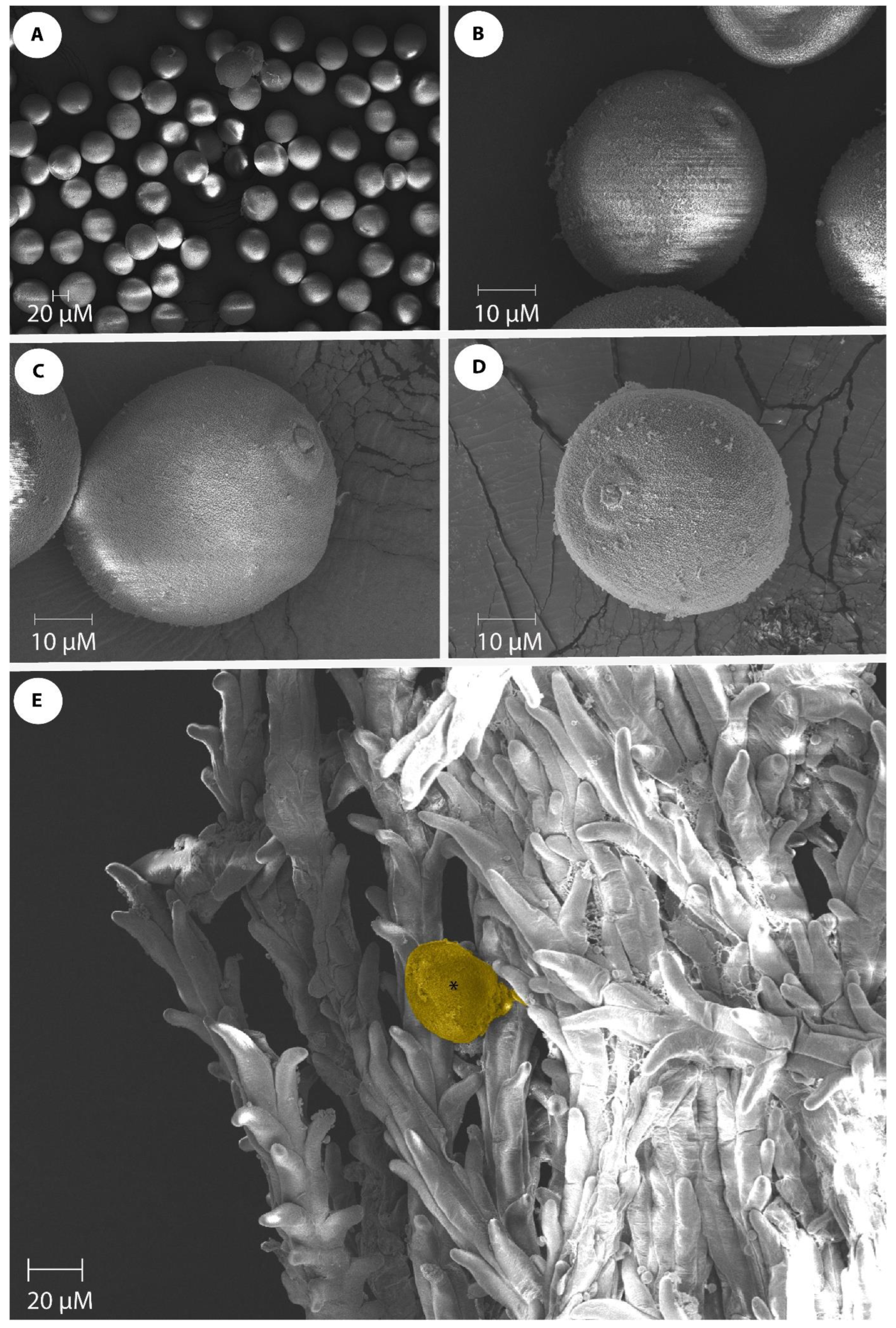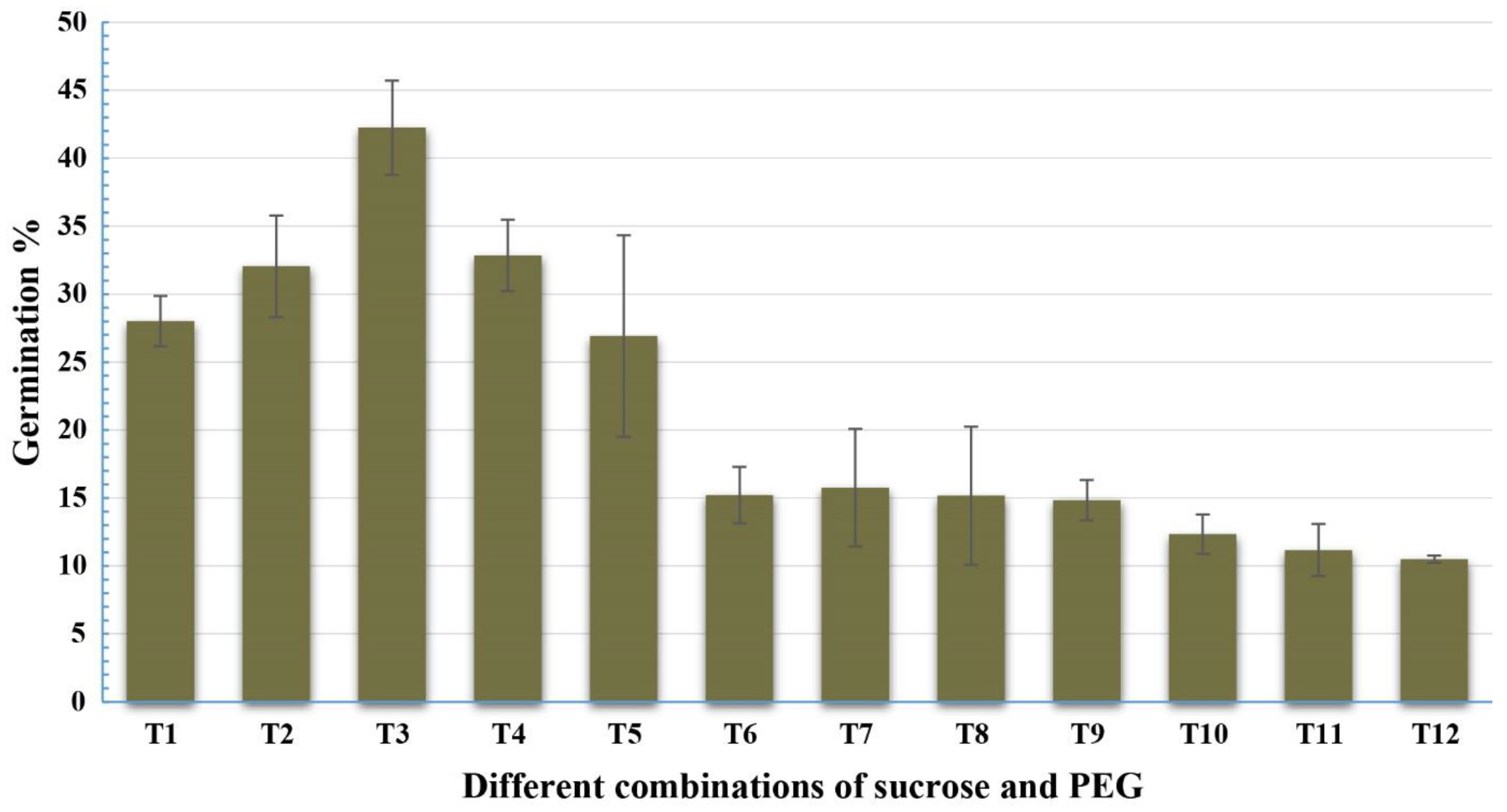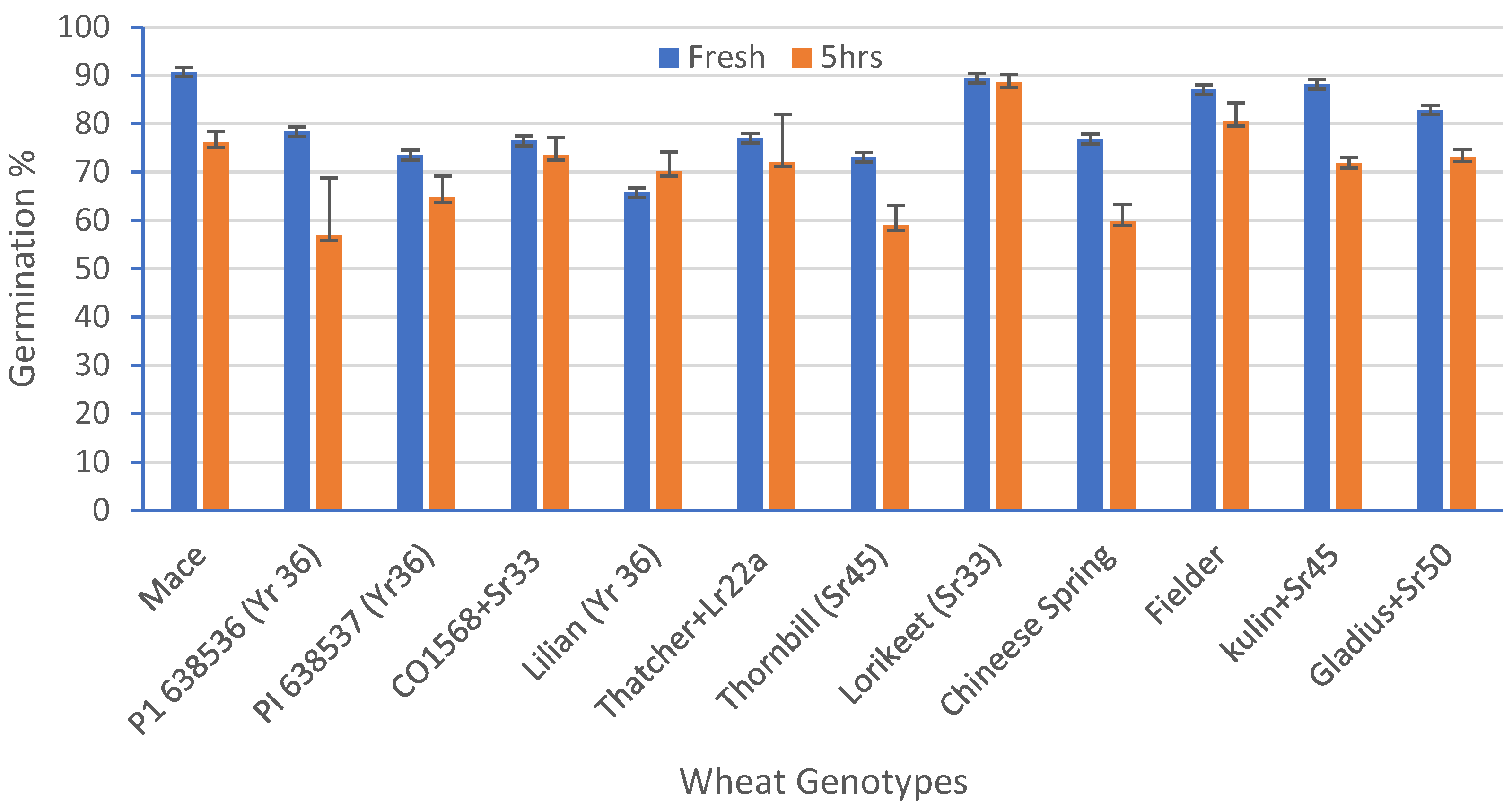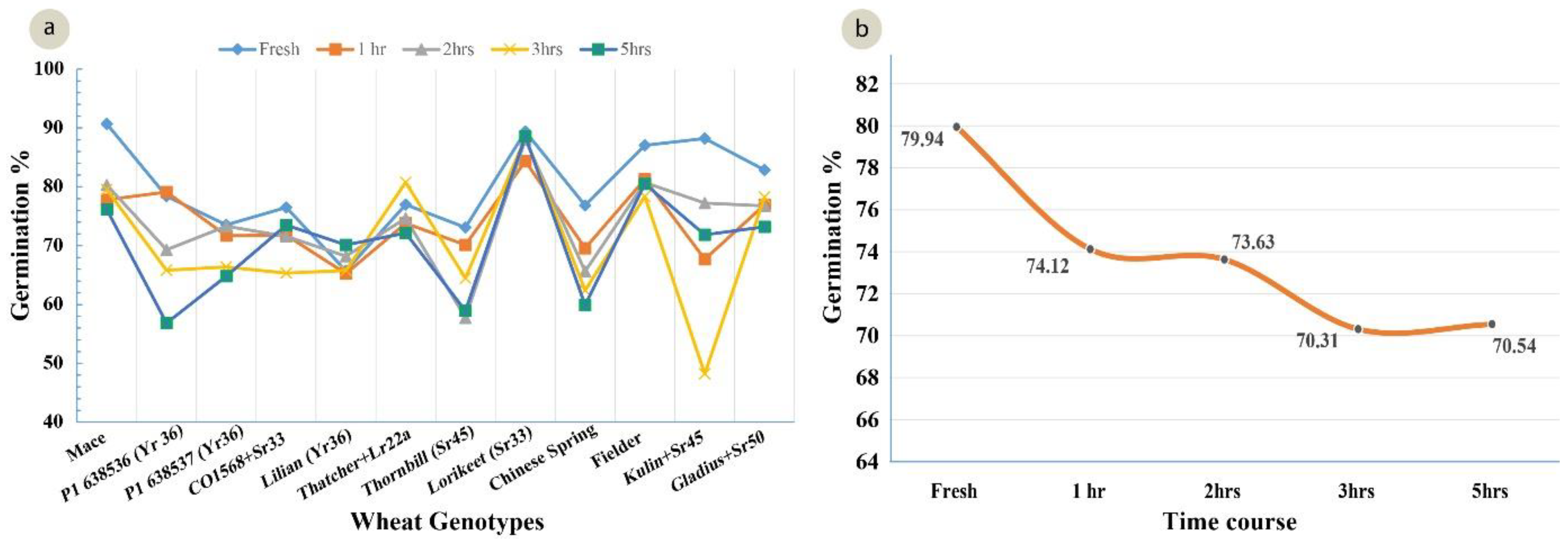Pollen: A Potential Explant for Genetic Transformation in Wheat (Triticum aestivum L.)
Abstract
:1. Introduction
2. Materials and Methods
2.1. Plant Material
2.2. Pollen Collection
2.3. Pollen Morphology under Scanning Electron Microscope (SEM)
2.4. Development of a Standardized In Vitro Pollen Germination Medium
2.5. Assaying for Percentage of Pollen Germination
2.6. Assessment of Pollen Viability
2.7. Statistical Analysis
3. Results
3.1. Pollen Morphology under Scanning Electron Microscope (SEM)
3.2. Optimization of In Vitro Pollen Germination Media
3.2.1. Optimization of Sucrose and Polyethylene Glycol (PEG)
3.2.2. Optimization of pH, Boric Acid, and Calcium Nitrate
3.3. Assessment of Pollen Viability
4. Discussion
5. Conclusions
Supplementary Materials
Author Contributions
Funding
Data Availability Statement
Acknowledgments
Conflicts of Interest
References
- Alwen, A.; Eller, N.; Kastler, M.; Moreno, R.M.B.; Heberle-Bors, E. Potential of in vitro pollen maturation for gene transfer. J. Physiol. Plant. 1990, 79, 194–196. [Google Scholar] [CrossRef]
- Touraev, A.; Stöger, E.; Voronin, V.; Heberle-Bors, E. Plant male germ line transformation. Plant J. 1997, 12, 949–956. [Google Scholar] [CrossRef]
- Eapen, S. Pollen grains as a target for introduction of foreign genes into plants: An assessment. Physiol. Mol. Biol. Plants 2011, 17, 1–8. [Google Scholar] [CrossRef] [PubMed]
- Hess, D. Genetic transformation of wheat via pollen 25 years of plant transformation attempts II. In In Vitro Haploid Production in Higher Plants; Springer: Dordrecht, The Netherlands, 1996; pp. 393–409. [Google Scholar]
- Pandey, K.K. Sexual transfer of specific genes without gametic fusion. Nature 1975, 256, 310–313. [Google Scholar] [CrossRef] [PubMed]
- Hess, D. Uptake of DNA and bacteriophage into pollen and genetic manipulation. In Genetic Manipulations with Plant Material; Springer: Berlin/Heidelberg, Germany, 1975; pp. 519–537. [Google Scholar]
- Ohta, Y. High-efficiency genetic transformation of maize by a mixture of pollen and exogenous DNA. Proc. Natl. Acad. Sci. USA 1986, 83, 715–719. [Google Scholar] [CrossRef]
- Hess, D.; Dressler, K.; Nimmrichter, R. Transformation experiments by pipetting Agrobacterium into the spikelets of wheat (Triticum aestivum L.). Plant Sci. 1990, 72, 233–244. [Google Scholar] [CrossRef]
- Martin, N.; Forgeois, P.; Picard, E. Investigations on transforming Triticum aestivum via the pollen tube pathway. Agron. EDP Sci. 1992, 12, 537–544. [Google Scholar] [CrossRef]
- Picard, E.; Jacquemin, J.; Granier, F.; Bobin, M.; Forgeois, P. Genetic transformation of wheat (Triticum aestivum) by plasmid DNA uptake during pollen tube germination. In Proceedings of the Seventh International Wheat Genetics Symposium, Cambridge, UK, 13–19 July 1988; pp. 779–781. [Google Scholar]
- Borisjuk, N.; Kishchenko, O.; Eliby, S.; Schramm, C.; Anderson, P.; Jatayev, S.; Shavrukov, Y. Genetic modification for wheat improvement: From transgenesis to genome editing. BioMed Res. Int. 2019, 2019, 6216304. [Google Scholar] [CrossRef]
- Risacher, T.; Craze, M.; Bowden, S.; Paul, W.; Barsby, T. Highly efficient Agrobacterium-mediated transformation of wheat via in planta inoculation. In Transgenic Wheat, Barley and Oats; Humana Press: Totowa, NJ, USA, 2009; pp. 115–124. [Google Scholar]
- Ishida, Y.; Tsunashima, M.; Hiei, Y.; Komari, T. Wheat (Triticum aestivum L.) transformation using immature embryos. In Agrobacterium Protocols; Springer: Berlin/Heidelberg, Germany, 2015; pp. 189–198. [Google Scholar]
- Pellegrineschi, A.; Noguera, L.M.; Skovmand, B.; Brito, R.M.; Velazquez, L.; Salgado, M.M.; Hoisington, D. Identification of highly transformable wheat genotypes for mass production of fertile transgenic plants. Genome 2002, 45, 421–430. [Google Scholar] [CrossRef]
- Jouanin, A.; Gilisen, L.J.W.J.; Schaart, J.G.; Leigh, F.J.; Cockram, J.; Wallington, E.J.; Boyd, L.A.; van den Broeck, H.C.; van der Meer, I.M.; America, A.H.P.; et al. CRISPR/CAS9 gene editing of gluten in wheat to reduce gluten content and exposure-reviewing methods to screen for coeliac safety. Front. Nutr. 2020, 7, 51. [Google Scholar] [CrossRef]
- Cheng, C.; Mcomb, J. In-vitro germination of wheat pollen on raffinose medium. New Phytol. 1992, 120, 459–462. [Google Scholar] [CrossRef]
- Jayaprakash, P.; Annapoorani, S.; Vikas, V.K.; Sivasamy, M.; Kumar, J.; Saravannan, K.; Sheeba, D. An improved in-vitro germination medium for recalcitrant bread wheat (Triticum aestivum L.) pollen. Indian J. Genet. Plant Breed. 2015, 75, 446–452. [Google Scholar] [CrossRef]
- Zadoks, J.C.; Chang, T.T.; Konzak, C.F. The growth stage code for cereals. Weed Res. 1974, 14, 415–421. [Google Scholar] [CrossRef]
- Ruzin, S.E. Plant Microtechnique and Microscopy; Oxford University Press: Oxford, UK, 1999; p. 322. [Google Scholar]
- Brewbaker, J.L.; Kwack, B.H. The essential role of calcium ion in pollen germination and pollen tube growth. Am. J. Bot. 1963, 50, 859–865. [Google Scholar] [CrossRef]
- Bokshi, A.I.; Tan, D.K.; Trethowan, R.M. A robust and rapid pollen viability test using impedance flow cytometry for high throughput screening of heat tolerant wheat (Triticum aestivum) germplasm. In Proceedings of the 2019 Agronomy Australia Conference, Wagga Wagga, NSW, Australia, 25–29 August 2019; Pratley, J., Ed.; Australian Society of Agronomy: Wagga Wagga, NSW, Australia, 2019. Available online: www.agronomyaustralia.org/ (accessed on 19 July 2022).
- Pinheiro, J.; Bates, D.; DebRoy, S.; Sarkar, D. DJU hcr-powpnih (2011) the R Development Core Team (2011) nlme: Linear and Nonlinear Mixed Effects Models, R package version 3 1–117.
- Halbritter, H.; Ulrich, S.; Grímsson, F.; Weber, M.; Zetter, R.; Hesse, M.; Frosch-Radivo, A. Illustrated Pollen Terminology; Springer: Cham, Switzerland, 2018. [Google Scholar] [CrossRef]
- Liu, Q.; Chen, B.; Wang, Q.; Shi, X.; Xiao, Z.; Lin, J.; Fang, X. Carbon nanotubes as molecular transporters for walled plant cells. Nano Lett. 2009, 9, 1007–1010. [Google Scholar] [CrossRef] [PubMed]
- Behzadi, S.; Serpooshan, V.; Tao, W.; Hamaly, M.A.; Alkawareek, M.Y.; Dreaden, E.C.; Mahmoudi, M. Cellular uptake of nanoparticles: Journey inside the cell. Chem. Soc. Rev. J. 2017, 46, 4218–4244. [Google Scholar] [CrossRef]
- Zhao, X.; Meng, Z.; Wang, Y.; Chen, W.; Sun, C.; Cui, B.; Luo, D. Pollen magnetofection for genetic modification with magnetic nanoparticles as gene carriers. Nat. Plants 2017, 3, 956–964. [Google Scholar] [CrossRef]
- Vasil, V.; Castillo, A.M.; Fromm, M.E.; Vasil, I.K. Herbicide resistant fertile transgenic wheat plants obtained by microprojectile bombardment of regenerable embryogenic callus. J. Biotechnol. 1992, 10, 667–674. [Google Scholar] [CrossRef]
- Maës, O.C.; Chibbar, R.N.; Caswell, K.; Leung, N.; Kartha, K.K. Somatic embryogenesis from isolated scutella of wheat: Effects of physical, physiological and genetic factors. Plant Sci. 1996, 121, 75–84. [Google Scholar] [CrossRef]
- Richardson, T.; Thistleton, J.; Higgins, T.J.; Howitt, C.; Ayliffe, M. Efficient Agrobacterium transformation of elite wheat germplasm without selection. Plant Cell Tissue Organ Culture 2014, 119, 647–659. [Google Scholar] [CrossRef]
- Wang, K.; Liu, H.; Du, L.; Ye, X. Generation of marker-free transgenic hexaploid wheat via an Agrobacterium-mediated co-transformation strategy in commercial Chinese wheat varieties. Plant Biotechnol. J. 2017, 15, 614–623. [Google Scholar] [CrossRef]
- Ishida, Y.; Hiei, Y.; Komari, T. High-efficiency transformation techniques. In Applications of Genetic and Genomic Research in Cereals; Elsevier: Amsterdam, The Netherlands, 2019; pp. 97–120. [Google Scholar]
- Liu, Z.; Zhang, Z.; Shen, Y. Scanning electron microscope observation on pollen morphology and leaf epidermis in wheat, triticale and rye. Acta Agric. Boreali-Sin. 1992, 7, 23–28. [Google Scholar]
- Ressayre, A.; Godelle, B.; Mignot, A.; Gouyon, P.H. A morphogenetic model accounting for pollen aperture pattern in flowering plants. J. Theor. Biol. 1998, 193, 321–334. [Google Scholar] [CrossRef]
- MacFaddin, J.F. Media for Isolation, Cultivation, Identification and Maintenance of Medical Bacteria; Williams, Wilkims: Baltimore, MD, USA, 1985. [Google Scholar]
- Liu, J.X.; Liao, D.Q.; Oane, R.; Estenor, L.; Yang, X.E.; Li, Z.C.; Bennett, J. Genetic variation in the sensitivity of anther dehiscence to drought stress in rice. Field Crops Res. 2006, 97, 87–100. [Google Scholar] [CrossRef]
- Impe, D.; Reitz, J.; Köpnick, C.; Rolletschek, H.; Börner, A.; Senula, A.; Nagel, M. Assessment of pollen viability for wheat. Front. Plant Sci. 2020, 10, 1588. [Google Scholar] [CrossRef] [PubMed]
- Burke, J.J.; Velten, J.; Oliver, M.J. In-vitro analysis of cotton pollen germination. Agron. J. 2004, 96, 359–368. [Google Scholar] [CrossRef]
- Mbogning, J.; Youmbi, E.; Nkongmeneck, B. Morphological and in-vitro germination studies of pollen grains in kola tree (Cola sp.). Akdeniz Üniv. Ziraat Fakült. Derg. 2007, 20, 311–318. [Google Scholar]
- Ahmad, N.M.; Martin, P. Pollen morphology and physiology of Poa labillardieri (Poaceae). Int. J. Plant Reprod. Biol. 2017, 2, 139–147. [Google Scholar]
- Cheng, C.; Rerkasem, B. Effect of boron on pollen viability in wheat. Plant Soil 1993, 155, 313–315. [Google Scholar] [CrossRef]
- Tuinstra, M.R.; Wedel, J. Estimation of pollen viability in grain sorghum. Crop Sci. 2000, 40, 968–970. [Google Scholar]
- Steinhorst, L.; Kudla, J. Calcium-a central regulator of pollen germination and tube growth. Biochim. Biophys. Acta (BBA) Mol. Cell Res. 2013, 1833, 1573–1581. [Google Scholar] [CrossRef] [PubMed]
- Patel, R.G.; Mankad, A.U. In-vitro pollen germination—A review. Int. J. Sci. 2014, 3, 304–307. [Google Scholar]
- Alexander, M.P. Differential staining of aborted and nonaborted pollen. Stain Technol. 1969, 44, 117–122. [Google Scholar] [CrossRef] [PubMed]
- La Porta, N.; Roselli, G. Relationship between pollen germination in-vitro and fluorochromatic reaction in cherry clone F12/1 (Prunus avium L.) and some of its mutants. J. Hortic. Sci. 1991, 66, 171–175. [Google Scholar] [CrossRef]
- Trognitz, B.R. Comparison of different pollen viability assays to evaluate pollen fertility of potato dihaploids. Euphytica 1991, 56, 143–148. [Google Scholar] [CrossRef]
- Sedgley, M.; Harbard, J. Pollen storage and breeding system in relation to controlled pollination of four species of Acacia (Leguminosae: Mimosoideae). Aust. J. Bot. 1993, 41, 601–609. [Google Scholar] [CrossRef]
- Heidmann, I.; Schade-Kampmann, G.; Lambalk, J.; Ottiger, M.; Di Berardino, M. Impedance flow cytometry: A novel technique in pollen analysis. PLoS ONE 2016, 11, e0165531. [Google Scholar] [CrossRef]
- De Vries, A.P. Flowering biology of wheat, particularly in view of hybrid seed production—A review. Euphytica 1971, 20, 152–170. [Google Scholar] [CrossRef]
- Stanley, R.G.; Linskens, H.F. Pollen: Biology Biochemistry Management; Business Media; Springer Science: Berlin/Heidelberg, Germany, 1974. [Google Scholar]
- Baninasab, B.; Tabori, M.; Yu, J.; Zhang, Y.; Wang, X.; Deschiffart, I.; Khanizadeh, S. Low temperature storage and in-vitro pollen germination of selected spring wheat accessions. J. Agric. Sci. 2017, 9, 9. [Google Scholar] [CrossRef]
- Stöger, E.; Moreno, R.M.B.; Ylstra, B.; Vicente, O.; Heberle-Bors, E. Comparison of different techniques for gene transfer into mature and immature tobacco pollen. Transgenic Res. 1992, 1, 71–78. [Google Scholar] [CrossRef]
- Schreiber, D.N.; Dresselhaus, T. In-vitro pollen germination and transient transformation of Zea mays and other plant species. Plant Mol. Biol. 2003, 21, 31–41. [Google Scholar] [CrossRef]
- Wang, W.; Wang, J.; Yang, C.; Li, Y.; Liu, L.; Xu, J. Pollen-mediated transformation of Sorghum bicolor plants. Biotechnol. Appl. Biochem. 2007, 48, 79–83. [Google Scholar] [CrossRef] [PubMed]
- Fritz, S.E.; Lukaszewski, A.J. Pollen longevity in wheat, rye and triticale. Plant Breed. 1989, 102, 31–34. [Google Scholar] [CrossRef]
- McCormick, S. Control of male gametophyte development. Plant Cell 2004, 16, S142–S153. [Google Scholar] [CrossRef] [PubMed]






| Wheat Genotypes | Pollen Polar Axis Length (P) * (µm ± SE) | Range of Polar Axis Length | Pollen Equatorial Axis Length (E) * (µm ± SE) | Range of Equatorial Axis Length | P/E Ratio | Aperture Diameter (µm + SE) |
|---|---|---|---|---|---|---|
| Kulin+Sr45 | 46.86 ± 1.40 ab | 43.2–50.0 | 46.07 ± 1.25 a | 43.0–49.9 | 1.01 | 4.4 ± 0.04 d |
| Gladius+Sr50 | 45.73 ± 1.64 bc | 38.8–49.7 | 43.06 ± 1.75 cd | 37.6–48.4 | 1.06 | 5.0 ± 0.04 b |
| Lilian (Yr18, Yr36) | 47.03 ± 1.78 ab | 36.8–51.4 | 44.90 ± 1.97 ab | 37.7–49.8 | 1.04 | 3.0 ± 0.03 g |
| CO1568+Sr33 | 47.03 ± 1.18 ab | 41.8–50.9 | 42.83 ± 1.56 d | 38.1–46.8 | 1.10 | 5.6 ± 0.04 a |
| Thatcher+Lr22a | 47.80 ± 1.62 a | 42.6–51.6 | 44.50 ± 1.14 bc | 40.6–47.9 | 1.07 | 4.0 ± 0.03 f |
| Chinese Spring | 44.40 ± 1.07 c | 40.8–48.1 | 40.96 ± 1.67 e | 36.4–46.3 | 1.08 | 4.2 ± 0.04 e |
| Fielder | 40.06 ± 1.76 d | 33.1–45.7 | 37.83 ± 1.56 f | 33.0–41.8 | 1.06 | 4.5 ± 0.03 c |
| No. | Treatments | Modifications | Basic Composition | ||||
|---|---|---|---|---|---|---|---|
| Sucrose (%) | PEG (%) | Boric Acid (mg/L) | Calcium Nitrate (mg/L) | Potassium Nitrate (mg/L) | Magnesium Sulphate (mg/L) | ||
| 1 | T1 | 5 | 0 | 100 | 300 | 100 | 200 |
| 2 | T2 | 5 | 5 | 100 | 300 | 100 | 200 |
| 3 | T3 | 5 | 10 | 100 | 300 | 100 | 200 |
| 4 | T4 | 5 | 15 | 100 | 300 | 100 | 200 |
| 5 | T5 | 10 | 0 | 100 | 300 | 100 | 200 |
| 6 | T6 | 10 | 5 | 100 | 300 | 100 | 200 |
| 7 | T7 | 10 | 10 | 100 | 300 | 100 | 200 |
| 8 | T8 | 10 | 15 | 100 | 300 | 100 | 200 |
| 9 | T9 | 15 | 0 | 100 | 300 | 100 | 200 |
| 10 | T10 | 15 | 5 | 100 | 300 | 100 | 200 |
| 11 | T11 | 15 | 10 | 100 | 300 | 100 | 200 |
| 12 | T12 | 15 | 15 | 100 | 300 | 100 | 200 |
| Source of Variation (SoV) | Degree of Freedom (df) | Sum of Square (SS) | Mean Sum of Square (MSS) | F-Value |
|---|---|---|---|---|
| PEG | ||||
| Treatments | 11 | 3628.42 | 329.857 ** | 8.88 |
| Error | 24 | 891.28 | 37.14 | |
| Total | 35 | 4519.70 | ||
| pH | ||||
| Treatments | 3 | 4290.99 | 1430.33 ** | 13.20 |
| Error | 8 | 866.64 | 108.33 * | |
| Total | 11 | 5157.63 | ||
| Boric acid | ||||
| Treatments | 3 | 900.92 | 300.30 * | 4.31 |
| Error | 8 | 558.00 | 69.75 | |
| Total | 11 | 1458.92 | ||
| Calcium nitrate | ||||
| Treatments | 3 | 1433.58 | 477.86 * | 5.29 |
| Error | 8 | 722.66 | 90.33 | |
| Total | 11 | 2156.25 |
| SoV | Df | SS | MS | F-Value |
|---|---|---|---|---|
| Genotypes | 11 | 16,238 | 1476.2 ** | 9.394 |
| Time | 4 | 4360 | 1089.9 ** | 6.936 |
| Genotypes × time | 44 | 7633 | 173.5 ns | 1.104 |
| Error | 300 | 47,140 | 157.1 | - |
| Total | 359 | - | - | - |
Publisher’s Note: MDPI stays neutral with regard to jurisdictional claims in published maps and institutional affiliations. |
© 2022 by the authors. Licensee MDPI, Basel, Switzerland. This article is an open access article distributed under the terms and conditions of the Creative Commons Attribution (CC BY) license (https://creativecommons.org/licenses/by/4.0/).
Share and Cite
Kanwal, M.; Gogoi, N.; Jones, B.; Bariana, H.; Bansal, U.; Ahmad, N. Pollen: A Potential Explant for Genetic Transformation in Wheat (Triticum aestivum L.). Agronomy 2022, 12, 2009. https://doi.org/10.3390/agronomy12092009
Kanwal M, Gogoi N, Jones B, Bariana H, Bansal U, Ahmad N. Pollen: A Potential Explant for Genetic Transformation in Wheat (Triticum aestivum L.). Agronomy. 2022; 12(9):2009. https://doi.org/10.3390/agronomy12092009
Chicago/Turabian StyleKanwal, Mehwish, Neelam Gogoi, Brian Jones, Harbans Bariana, Urmil Bansal, and Nabil Ahmad. 2022. "Pollen: A Potential Explant for Genetic Transformation in Wheat (Triticum aestivum L.)" Agronomy 12, no. 9: 2009. https://doi.org/10.3390/agronomy12092009
APA StyleKanwal, M., Gogoi, N., Jones, B., Bariana, H., Bansal, U., & Ahmad, N. (2022). Pollen: A Potential Explant for Genetic Transformation in Wheat (Triticum aestivum L.). Agronomy, 12(9), 2009. https://doi.org/10.3390/agronomy12092009









